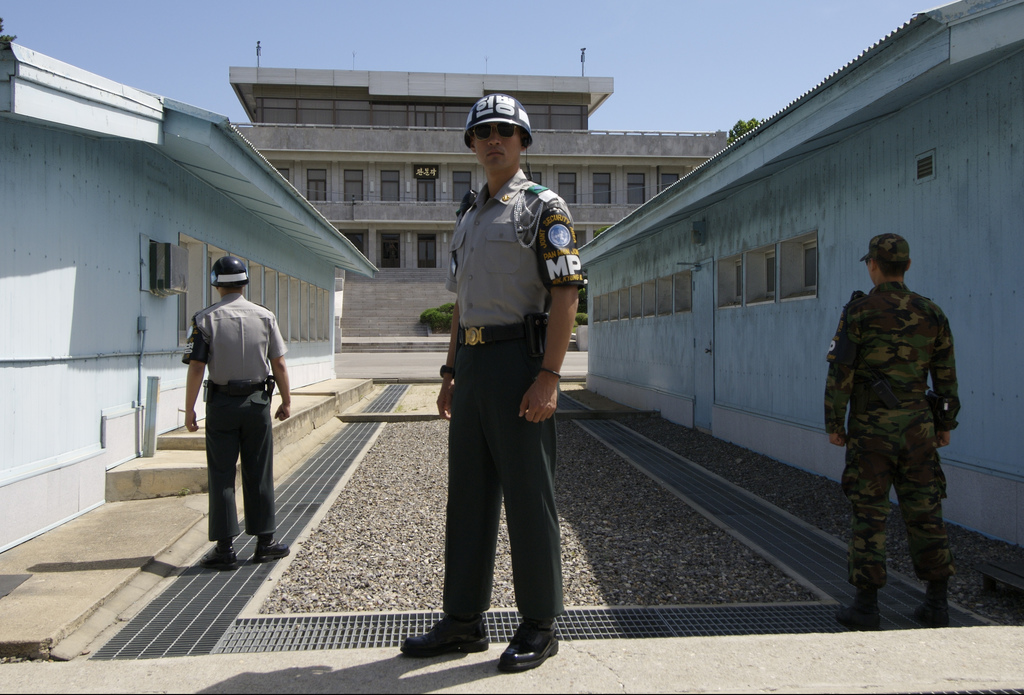The Peninsula
November 2015: Bookended by Military Operations, Talks Move Forward in Inter-Korean Relations
Published December 10, 2015
Author: Nicholas Hamisevicz
Category: North Korea, Inter-Korean, South Korea

By Nicholas Hamisevicz
In November, both Koreas continued to demonstrate a willingness for inter-Korean contact while also maintaining a commitment to improve security. Military actions over the past few months have not scuttled opportunities for dialogue. Inter-Korean talks in November led to scheduling talks set for December 11 at the vice minister level. The two sides will now have to consider further whether the possibilities of cooperation outweigh security concerns.
On the positive side, the two Koreas were able to meet on November 26 to discuss possibilities for a higher-level meeting in the future. Both Koreas are still trying to implement parts of the August 25 agreement that was made following a month of increased tensions. In early August, two South Korean soldiers were injured by land mines at the Demilitarized Zone (DMZ); the South Korean government said that the land mines were recently placed along the border by North Korea and responded by reinstituting the process to pump propaganda broadcasts over the DMZ into North Korea via loudspeakers. In October, North and South Korea were able to conduct family reunions, checking off one aspect of the agreement. The two sides are now working on another section of the August 25 agreement in which the two Koreas promised they would hold high-level talks.
At the November 26 meeting, the two Koreas agreed to hold vice-minister level talks in Kaesong, North Korea on December 11. It appears that North Korea would like to discuss the possibility of resuming suspended tourism operations to Mount Kumgang in North Korea as part of this dialogue. South Korea seems to want an arrangement for regularized family reunions and high-level inter-governmental meetings between the two Koreas. Different agenda items at this stage shouldn’t be surprising; however, separate aspirations could make it more difficult to reach an agreement.
In addition to the governmental talks, the two sides also had smaller exchanges in November. South Korean National Assembly members were allowed to take a day trip to Kaesong to visit ancient Korean burial sites. After an initial ban, South Korean officials associated with the running of the Kaesong Industrial Complex were permitted back into North Korea. Similar to a visit to North Korea by South Korean Catholic priests in October, Buddhist leaders from both Koreas were able to meet in Kaesong. Lastly, North and South Korean cooperation with Russia in regard to bulk cargo shipping moved forward with further tests for getting Russian coal to South Korea via railroads and the port in Rajin, North Korea. These smaller interactions help create an environment of regular contact and were supplements to the higher-level inter-Korean meeting.
Despite these signs of progress, the two Koreas continued to conduct military operations that could easily give either side an excuse to cease further interactions. Three days before the November 26 talks with North Korea, the South Korean military engaged in artillery exercises to coincide with the anniversary of North Korea’s shelling of Yeonpyeong Island. North Korea subsequently threatened South Korea and argued that the artillery drills might prevent North Korean officials from attending the talks. The Park administration went ahead with the exercises regardless. President Park even emphasized that strong security is an important part of her administration’s policy to build better inter-Korean relations.
Two days after the November 26 meeting, North Korea demonstrated its continuing plans to develop a submarine-launched ballistic missile capability. Having claimed a successful underwater missile test in May 2015, it conducted another test on November 28. As he did for the earlier test, Kim Jong-un was believed to have attended this launch as well. U.S. and South Korea media reports cited intelligence officials as saying that the test was not an overall success.
November 2015 was another month that demonstrated that the two Koreas could carry out positive interactions while at the same time bolstering their defenses. Shortly before and after the inter-Korean talks on November 26, both Koreas conducted military operations that could be interpreted as threatening, giving either government a reason to move forward cautiously, or to stop progress altogether. Can the two Koreas continue to have exchanges within the context of military enhancements by both sides? The vice-ministerial meeting on December 11 and other events in December will be key to determining whether sustained interaction between North and South will continue.
Nicholas Hamisevicz is currently undertaking a PhD in World Politics at Catholic University. Previously he was the Director of Research and Academic Affairs for the Korea Economic Institute of America. The views represented here are his own.
Photo from Morning Calm Newsletter’s photostream on Flickr Creative Commons.
